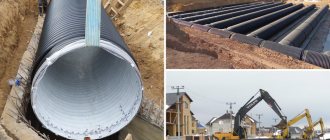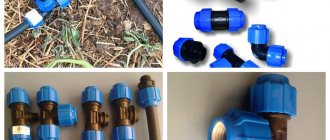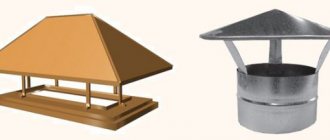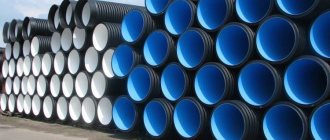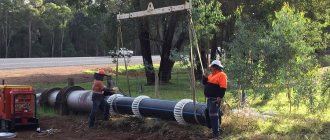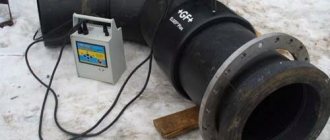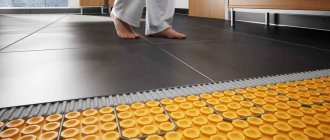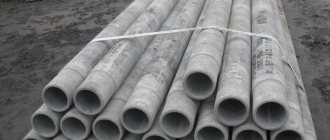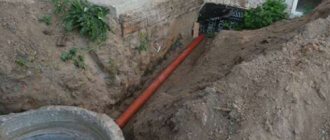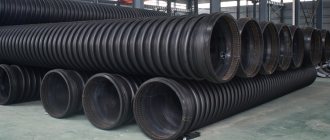When making sewerage in a private home or enterprise, you will always be faced with the problem of choosing pipes. The modern plumbing market offers a huge number of different solutions, differing in size, shape, quality and manufacturer. It can be quite difficult to choose the best according to all these criteria, but we advise you to choose Korsis and KrosisPRO pipes, which are ideal for laying gravity sewers. It is also worth noting that Korsis double-layer pipes are suitable not only for intra-house wiring, but also for central sewer systems.
Where is Korsis produced?
"POLIPLASTIC Group" is a reliable manufacturer of Korsis pipes, which have established themselves as one of the most reliable products on the plumbing market. The company produces its plastic pipes at factories in Novocheboksarsk, Klimov, Angarsk, as well as in the Republic of Kazakhstan.
By offering to choose Korsis pipes, we mean a whole line of polymer products designed for the following purposes:
- Laying sewer systems;
- Disposal of waste (rain and melt) water;
- Water drainage;
- Rehabilitation of throughput pipes in the roadbed.
Ring stiffness, operating temperature and purpose
The pipes described are manufactured by the group. The company has well established itself as one of the most reliable suppliers of plumbing products. Plastic pipes are manufactured with different ring stiffness values. On sale you can find several modifications.
If you see Korsis PRO pipes, the characteristics of these products will be as follows: they are based on polypropylene, the color on the outside is black, on the inside - gray-blue. The ring stiffness is 12 or 6 SN. But for a Korsis pipe without the addition “PRO” in the name, the ring stiffness indicator can be equal to the limit from 4 to 8. It is based on polyethylene, the color on the outside is black, the color on the inside is white. These pipes can be operated at temperatures from 0 to + 40 °C. Installation can be carried out at a temperature range from - 40 to + 60 ° C.
When considering the characteristics of the Corsys PRO pipe, you should pay attention to the operating temperature. It varies from 0 to + 95 °C. The installation temperature in this case ranges from -20 to + 60 °C. The company offers for sale a line of polymer products that are intended for specific purposes, for example:
- water drainage;
- laying sewer systems;
- sanitization of flow pipes;
- wastewater disposal.
Classification of pipes "Corsis" and "Corsis PRO"
Different Korsis pipes have individual technical characteristics, so there is a simple classification system for them to make it easier for you to choose the right product:
- Korsis and Korsis PRO pipes are primarily distinguished by the material from which they are made: Korsis is made of polyethylene, and Korsis PRO is made of polypropylene.
- The structure of both pipes is the same, but it also deserves attention. Korsis pipes consist of two layers: a smooth inner layer and a corrugated outer layer. Korsis pipes and Korsis PRO pipes can also be distinguished by the color of the inner layer: in the first version it is white, and in the second it is blue.
- SN is an indicator of ring stiffness. Each Korsis pipe has different SN characteristics, but the corrugated surface allows it to withstand heavy loads on the pipe rings of any product. When selecting Corsys pipes, it is necessary to carefully consider the required indicator of ring stiffness, because, for example, when laying pipes under a highway or under an aircraft, it is necessary to select only high-quality pipes with sufficient strength to withstand external mechanical influences, otherwise this may lead to an accident. The stiffness of pipes is measured in kN/sq.m., and the specific indicators of Korsis pipes are 4.6.8 kN/sq.m. for polyethylene products, and 12, 16 kN/sq.m. for polypropylene "Corsis PRO".
- The supplied pipes may also have different configurations. Typically, pipes are supplied either with a welded socket, which is attached to the sealing ring for pipes with a diameter of more than 250 mm, or without it.
- The length of the pipes is usually 6 or 12 m. The pipes are cut along the lower corrugation, so the manufacturer can allow deviations of 1% from the specified footage.
- Installation of Corsys pipes is carried out at temperatures from -40 to +60°C, and Corsys PRO can be installed at temperatures from -20 to +60°C.
- Corsis pipes for sewerage also differ in the maximum value of their operating temperature. The Corsys PRO pipe is capable of conducting liquids with a temperature of +95°C, but the Corsys pipe can only withstand liquids with a temperature of 40°C.
Installation of inspection wells
These independent structural elements are an integral part of the sewer system.
Wells can be made of polyethylene or concrete. Polyethylene structures are divided into two main types. The first type contains a monolithic cast element at the base, which is connected to a vertical section of the pipe. To connect a sewer pipe to it, rubber seals in the form of rings are used, ensuring a waterproof connection.
The second type is different in that it consists of pipe sections welded together. The connection to the main elements occurs using couplings.
If a concrete well is installed, then it is necessary to ensure that the hole in the well corresponds as closely as possible to this indicator of the pipe. All connections are coated with cement mortar.
During the work, a support should be installed for the free end of the polyethylene pipe, which is intended to enter the well wall. First, the work of concreting the well is carried out and only after hardening the pipe is connected.
It is impossible to do two jobs at the same time, as this can cause deformation of the highway under the influence of heavy concrete masses.
Technical characteristics of polypropylene material
- Polypropylene melts at a temperature of 168ºC.
- Density is 910 per kg.
- The tensile strength is 25–28 MPa.
- The elongation limit at break is more than 200%.
- The material becomes brittle at 20ºC below zero.
- The bending modulus is taken to be 1250–1650 MPa.
- The hardness of the pipe material according to the Rockwell scale is assumed to be 55–75 α.
- Thermal conductivity coefficient is in the range of 0.17–0.23 W per meter.
- The coefficient of specific heat capacity at a temperature of 20ºС is 1.95 kJ per kg.
Abrasion testing is usually carried out using two systems. The first is to determine the amount of material that has been subjected to abrasion and wear after the advancement of abrasive particles. The second indicator indicates the time during which the particles were worn out under the specified conditions.
Abrasion by abrasives occurs due to friction during the rolling of certain abrasive particles, cutting off material components by them, if the flow consists of uneven, sharp and hard elements.
A number of studies conducted by specialists indicate that the mechanism of self-cleaning and deposition of microparticles on the walls of the pipe are directly related to the process of material abrasion.
Sewer underground and above-ground pipeline systems made of polyethylene with a ribbed outer surface are developing and are gradually replacing all other materials for drainage devices. Because of their high performance qualities, they are popular among builders.
Details about polypropylene pipes "Corsis PRO"
Having become familiar with the main differences and characteristics, let's talk about each class of pipes from. Let's start with the PRO series, which is manufactured using imported components, for example, high-modulus block copolymer. Thanks to high-quality raw materials, high reliability and durability of the finished product is achieved.
When choosing pipes, you must know what they are used for. The following systems are performed using Corsys PRO pipes:
When choosing two-layer profiled pipes Korsis PRO, you also need to know about their individual advantages:
- Pipe corrugation allows you to achieve a high level of rigidity, as a result of which the pipe can be laid even at a depth of 15 m;
- High resistance to other mechanical influences;
- Absolute resistance to various chemical influences, as well as environmental influences, such as soil;
- Pipes are convenient and easy to transport and install. Additionally, this process is facilitated by a wide selection of different fittings, which not only allow you to connect pipes to each other, but also connect them to any structures;
- A wide range of operating temperatures allows you to remove not only cold, but also hot liquids.
It is worth dwelling on the last point in more detail, because it also hides a significant drawback of this pipe. The operating temperature of the pipe, as we specified earlier, is from -20 to +95 °C, which indicates the impossibility of openly laying such a pipe on the street.
We also recommend paying attention to the additional characteristics and thresholds of the Corsys PRO pipe:
- Density is 900 kg per cubic meter;
- The mass fraction of carbon is from 2 to 2.5;
- When working with particularly hot liquids (200 °C), the pipe will hold for up to 8 minutes;
- At a pressure of 4.2 Pa and a temperature of 80 °C, the pipe will last approximately 140 hours;
- At a pressure of 2.5 Pa and heating to 95 °C, the pipe will work properly for 1000 hours.
Next, it is worth indicating the ranges of various sizes and indicators, which often depend on each other:
- The external and internal diameter of such a pipe ranges from 110/91 to 1000/851 mm;
- The wall thickness (without corrugation protrusion) ranges from 1 to 5 mm;
- The width of the corrugation protrusion can be from 8.6 to 60 mm;
- Pipes with ring stiffness SN12 have a weight from 0.84 to 40.69 kg;
- Pipes with ring stiffness SN12 have a weight from 0.92 to 44.79 kg.
When buying pipes in a store, carefully look at their appearance: there should be no dents or cracks on the surface. Equally important is the marking, which is applied by printing or sticking a label along the corrugation. It indicates the manufacturer, release date and batch number. Often it also contains additional information about the pipe.
Details about Korsis polyethylene pipes
The second line of pipes is practically not inferior to the Corsys PRO pipes, but has a number of distinctive properties. First, let's look at their positive qualities:
- Polyethylene is cheaper than polypropylene, so ready-made sewer polyethylene pipes are also supplied at a reduced price;
- The pipe perfectly withstands various physical, chemical and natural influences;
- Transportation and installation of Korsis pipes will not require large amounts of time and money;
- Fittings are also available for such a pipe, making it easy to connect the pipes to each other and to other structures;
- The smoothness of the inner surface allows you to achieve high throughput and also relieve the pipe from clogging;
- A minor advantage is also the ability to install the pipe in severe frosts down to -40°C.
Korsis pipe connection
Having purchased the necessary pipes, it’s time to install them, connecting them together. There are three available ways to do this:
- Using a special coupling;
- Butt welding pipes;
- Using a socket connection.
We will talk in detail about each method, but let's start with the first. Couplings are used in almost all cases, because this way you can achieve the most reliable connection. Read also: “Pragma sewer pipes - characteristics and advantages over analogues.”
The coupling is secured with an O-ring, which is secured to the pipes in two ways:
- For a pipe with a diameter of up to 200 mm, the ring is put on the second wave of corrugation;
- For a pipe with a diameter of more than 200 mm, the ring is put on the first wave.
As a result, you will get a reliable and tight connection.
Butt welding is rarely used for sewer pipes, because they are usually produced in large diameters. To weld the two ends of the pipes, you need to put them in a special welding machine, which will melt the ends and join them. After hardening, you will receive an equally reliable connection, but you will spend more time, effort and money.
The socket connection is especially popular for pipes with a wide diameter. Often, the pipe manufacturer pre-welds the socket to products with a diameter of 250 mm or more. The pipe is driven into the socket using silicone grease, after which it is additionally secured with an O-ring.
What you need to know about installing Korsis pipes
Korsis pipes allow you to easily install inspection wells, which come in the following types:
- Inspection;
- Trays, which are used in housing and communal networks;
- Gutterless ones are built for road and storm drainage systems;
- Drop wells are used for systems with different levels of inlet and outlet pipes;
- Tangential wells have a wide diameter; as a rule, a wide platform and a ladder are installed in them.
For laying well shafts, Corsys PRO and Corsys PLUS pipes with a diameter of 630 to 2200 mm are used. To secure the neck and shaft, O-rings are used; a special adapter is also used, which allows the exit from the well to the shaft to be made at a certain angle.
Rules for installing Korsis sewer pipes:
- It is recommended to hire specialists for installation;
- When connecting pipes, thoroughly clean the joints from various contaminants;
- Under no circumstances should you lubricate the joints with oil, which will significantly shorten the service life of the plastic pipe. Lubricate only with water-repellent silicone;
- When installing Korsis pipes, we recommend using fittings from the same company;
- Always comply with operating requirements, such as operating temperature thresholds.
For sewer systems, both external and underground, various pipes and components are used. The characteristics of the materials that manufacturers use are quite varied, these are: polyethylene and polypropylene, PVC pipelines, as well as fiberglass.
Under the KORSIS trademark (Polyplastic group), products are made from polyethylene (PE) or other similar polymers, which are used for non-pressure drainage systems, as well as storm and domestic sewer networks.
This group of products competes with reinforced concrete pipelines, which are not without negative qualities and are gradually leaving the market. Although, polyethylene products have their own characteristics, which are better known in advance.
What it is
Products under the Korsis brand are manufactured by the domestic company Poliplastik, founded in 1991. The company is the largest manufacturer of polymer pipes, fittings for them, shut-off and control valves, plastic manholes and other plastic products in the post-Soviet space.
The purpose of the pipes is drainage and sewerage, and their key feature is the corrugation of the walls.
Corrugation increases ring rigidity with minimal material consumption. Relatively low plastic consumption means affordable product prices for the consumer.
Corrugation negatively affects the hydraulic resistance of the pipeline, and for sewerage it also means the accumulation of waste carried by drains in the depressions. In Korsis products this problem is solved simply and elegantly: their walls are made of double walls. The outer corrugated shell provides rigidity, and the smooth inner shell ensures trouble-free transportation of water and wastewater.
Product Features
In most cases, the KORSIS company produces products from low-density polyethylene (PE) or polymers. Polyethylene is often mixed with other substances, thus forming an alloy assembly of increased strength and reliability.
The advantages of polyethylene (PE) over its closest competitors are obvious. Unlike reinforced concrete pipes, polyethylene pipes are much lighter, while their strength is at a fairly high level. They do not react to moisture and are very durable.
It does not matter how long ago the pipe was installed. Even after 50 years, they will withstand the prescribed loads and perform their functions as intended.
If we compare them with metal products, then the exceptional low cost of polyethylene and its resistance to corrosion immediately catches the eye.
For sewerage systems that are primarily laid underground, the ability of the pipe to lie underground for a long time without destruction or serious damage is perhaps the most important indicator. This is what most modern builders focus on.
Product advantages
The company's main product is a corrugated two-layer pipe (the outer wall is profiled, the inner wall is smooth) made of co-extruded polyethylene. Products manufactured in this way are characterized by durability, chemical resistance and frost resistance.
Corrugated products are also popular for their exceptional strength, which is very important when constant loads from several meters of bulk soil begin to act on the pipe.
The ribs of the corrugation are designed in such a way as to strengthen its cross-section and redistribute the load. Breaking a pipe along its edge is a very difficult task. It is also almost impossible to break through it during installation. But there is also an internal smooth layer of polymers.
Plastic corrugated pipes
It is not surprising that pipes from this company are so popular. After all, one can only envy their reliability, durability and functionality. And this is at a fairly low price for the product itself.
In addition, this type of product has the following qualities:
- Due to the properties of polyethylene, it has sufficient impact resistance and abrasion resistance;
- Due to the material used and successful design, it has high ring rigidity;
- Easy installation and low weight, which is convenient for transportation;
- Due to the technology used, they can be quite large in diameter.
As a result, by providing products that are of better quality than PVC pipes, KORSIS occupies a large niche in the market.
In comparison with other analogues on the market of sewer polymer products, KORSIS demonstrates relatively better resistance to low temperatures than the main competitor PRAGMA, while the products of the second manufacturer have a relatively higher throughput of the products themselves.
Among the disadvantages of corrugated products, one can note the impossibility of connecting them using the simplest welding methods, as is done with samples that have a smooth surface.
So, you can weld a saddle onto smooth polyethylene pipes without any problems or cut a hole for a new terminal. Corrugation does not lend itself to such manipulations; a special coupling is needed.
Areas of use
All Korsis are designed for transporting wastewater - domestic, industrial (except high-temperature) and storm water. However, for some lines the manufacturer mentions additional functionality:
- Korsis and Pro can be used to restore worn out or partially destroyed pipelines: they are pulled through the old sewer line and take over its functions. In this case, the throughput practically does not suffer: the smaller cross-section is compensated by smooth walls and, accordingly, minimal hydraulic resistance of the new pipe;
- They can also be used to repair culverts under roads and to make plastic wells;
- The Protect and Plus lines are used for the construction of protective cases for underground pipelines;
- Spiroline is even used for the construction of sewage pumping stations (sewage pumping stations), pontoons and reservoirs for technical fluids and water.
Product varieties
Now let's look at the popular options that the company offers its customers. They have been on the market for a long time and have managed to gain remarkable popularity.
These products are produced in several model ranges:
- Double-layer corrugated pipes KORSIS;
- PRO series (polypropylene, multilayer);
- ECO series (material – recycled polyethylene);
- ARM series – reinforced series;
- PLUS series - increased diameter;
- SVT series – spiral-wound, optimized for external sewerage.
The main model range is currently represented by two subtypes with different ring stiffness - SN 8 and SN 10. Corrugated sewer pipes from KORSIS are suitable for laying underground sewers, and the rigidity parameters allow them to be used at different depths.
KORSIS pipes for sewerage are available in similar sizes.
The technical characteristics of the KORSIS pipe assume a nominal outer diameter of from 110 mm to 1200 mm, an operating temperature of the medium from 0 to +40 degrees, and short-term temperature fluctuations are allowed within the range from -40 to +60 degrees Celsius.
Laying of KORSIS pipes is carried out at a minimum depth, in the case of use in underground sewerage - 1 meter, the maximum depth is 15 meters. The service life, subject to operating rules, is more than 50 years.
Standard sizes of "ARM" in terms of internal diameter are from 800 to 2400 millimeters, while the ring stiffness class is SN 16. By agreement with the customer, the nominal ring stiffness of the pipe can be from SN 8 to SN 24.
KORSIS PRO series plastic pipes are also produced with a hardness of SN 16, the standard sizes correspond to the main KORSIS model range.
The diameters of the KORSIS series “PLUS” pipes in internal diameter range from 1200 to 2400 millimeters, stiffness classes – SN 2, 4, 6, 8.
Standard sizes of spiral products of the "SVT" series (type 1, without additional layers) in internal diameter - from 360 to 2800 millimeters, stiffness class - from SN 2 to SN 16. Pipes for external sewerage KORSIS of this variety are also available in "type 2" options and "type 3".
Installation features
In most cases, these pipes are laid underground. This is done using a trench or trenchless method. The first is preferable when you have a free site, an excavator and working hands.
Connection using coupling and welding
In this case, dig a trench of the required depth and width of 2-2.5 meters. Sand or special granules are poured onto its bottom. Then the pipes themselves are laid. To connect them, a coupling or welding is used. After this, the pipe is covered with small pebbles or sand with large inclusions.
The pipeline is backfilled so that its profile is completely covered with a protective layer. They can stretch warning tape even higher. It is necessary so that during future excavations the excavator operator does not accidentally damage the pipeline.
After all these steps are completed, the trench is backfilled and compacted.
Design methods
In matters of designing polyethylene highways, the final decision depends on the final cost of materials, installation and operation together with proper maintenance of complex structures. The customer, designer, contractor and operational service must work in close tandem and optimize all issues when choosing a route diagram, material, using installation methods and technology, and the mode of use of the finished sewer main.
For work, they use the provisions defined in SNiP for external networks and structures of water supply and sewerage and the standards for the design and installation of sewer and water supply systems.
For gravity sewers, it is recommended to calculate the speed of movement of wastewater in the range from 1 to 4 m per second; for rainwater, a flow of up to 7 m per second is recommended.
Korsis pipe series produced for consumers:
- type PRO is made of polypropylene with a multilayer construction and is produced with rib stiffness SN 16;
- ECO type is made from polyethylene after recycling and recycling;
- the APM type includes products with reinforced mesh in the pipe walls, has a ring stiffness of SN 16, according to the customer’s individual instructions this figure increases to SN 24;
- type PLUS is used in case of requirements to increase the flow diameter of pipes, the internal diameter is from 1200 to 2400 millimeters, rigidity - SN 2, 4, 6, 8;
- type SVT for external sewerage with spiral ribs.
Laying Corsys pipes
Although low-density polyethylene is highly durable, and the metal frame of corrugated pipes further enhances rigidity, in this regard, Korsis sewer pipes are inferior to their counterparts made of cast iron and steel. So, laying Korsis pipes in trenches should be done according to the same rules as other polymer pipes:
- The base should be soft soil, sand, small crushed stone or pebbles. If the soil in which the pipe is laid is rocky, a bulk foundation with a thickness of 100-150 mm should be made;
- The pipe is also filled with sand or small pebbles, up to a level of 300 mm above the upper edge of the pipe;
- If backfilling is done with local soil, large stones (larger than the corrugation profile), debris, etc. should be removed from it;
- In the case of unstable soils, where displacement is possible, the soil should be compacted.
How to connect Corsys pipes
Due to their low weight and the presence of special sockets and couplings, installation of Korsis pipes is quite simple, and the resulting connections are airtight. In total, three types of Korsis pipe connections are used.
Socket connection
The simplest and fastest way to install sewerage, carried out directly in the trench. The bell of one pipe and the end of the second, as well as the O-ring, should be cleaned. A special lubricant should be applied to the ring and bell. It both simplifies the connection and guarantees tightness. The sealing ring is put on the first cavity of the corrugation. The end of the pipe with the ring should be inserted into the socket until it stops.
The socket forms a reliable, hermetically sealed connection, but for diameters of 200 mm and less, Korsis exists only in a socketless version.
Korsis pipes, connection with couplings
This is a universal option, suitable for Korsis pipes of any diameter. It requires a special coupling. The technique and sequence of operations are similar to the socket joint.
The ends of the pipes, coupling, and sealing rings are cleaned. The inside surface of the coupling and the ring are coated with lubricant. For pipes with a diameter of 250 mm or more, the rings are put on the first cavity of the corrugation, for pipes 200 mm or less - on the second. With chalk or a marker, mark the place on the first pipe that corresponds to the stop of the coupling, and put the coupling on to the mark. The second pipe is pushed into the coupling until it stops.
For small diameters, you can push the coupling manually; for thick pipes, special devices may be required - a lever, a winch, a jack. It is prohibited to put on the coupling by hammering it with a hammer or sledgehammer.
